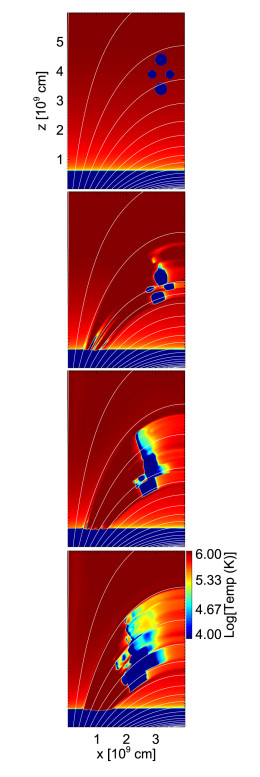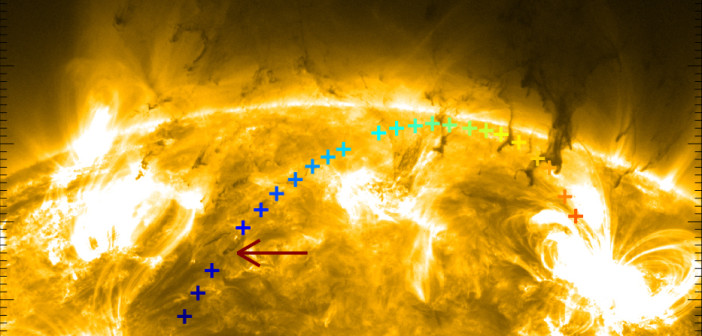Fallback from a Flare
On 7 June 2011, an M-class flare erupted from the solar surface. As the Solar Dynamics Observatory’s Atmospheric Imaging Assembly looked on, plasma fragments from the flare arced away from the Sun and then fell back to the surface.
Some fragments fell back where the Sun’s magnetic field was weak, returning directly to the surface. But others fell within active regions, where they crashed into the Sun’s magnetic field lines, brightening the channels and funneling along them through the dense corona and back to the Sun’s surface.

The authors’ model of the falling blobs at several different times in their simulation. The blobs get disrupted when they encounter the field lines, and are then funneled along the channels to the solar surface. [Adapted from Petralia et al. 2016]
Magnetic Fields as Guides
Petralia and collaborators used three-dimensional magnetohydrodynamical modeling to attempt to reproduce the observations of this event. They simulated blobs of plasma as they fall back to the solar surface and interact with magnetic field lines over a range of different conditions.
The team found that only simulations that assume a relatively strong magnetic field resulted in the blobs funneling along a channel to the Sun’s surface; with weaker fields the blobs to simply broke through the field lines.
The observations were best reproduced by downfall channeled in a million-Kelvin coronal loop confined by a magnetic field of ~10–20 Gauss. In this scenario, a falling fragment is deviated from its path by the field and disrupted. It’s then channeled along the magnetic flux tube, driving a shock and heating in the tube ahead of it — which, the authors find, is the cause the observed brightening that occurs ahead of the actual plasma passage.
Petralia and collaborators point out that this new mechanism for brightening downflows channeled by the magnetic field is applicable not only in our Sun, but also in young, accreting stars. Events like these can therefore work as probes of the ambient atmosphere of such stars, providing information about the local plasma density and magnetic field.
Bonus
Check out the two awesome videos below! In the first one, you can see the SDO/AIA observations of the plasma fragment falling back down and hitting a magnetic channel, which lights up as the shock propagates. In the second one, you can see one of the authors’ models of this process; this video renders the density of blobs of plasma as they fall and strike magnetic field lines.
Citation
A. Petralia et al 2016 ApJ 832 2. doi:10.3847/0004-637X/832/1/2



1 Comment
Pingback: falling solar plasma bombs with video